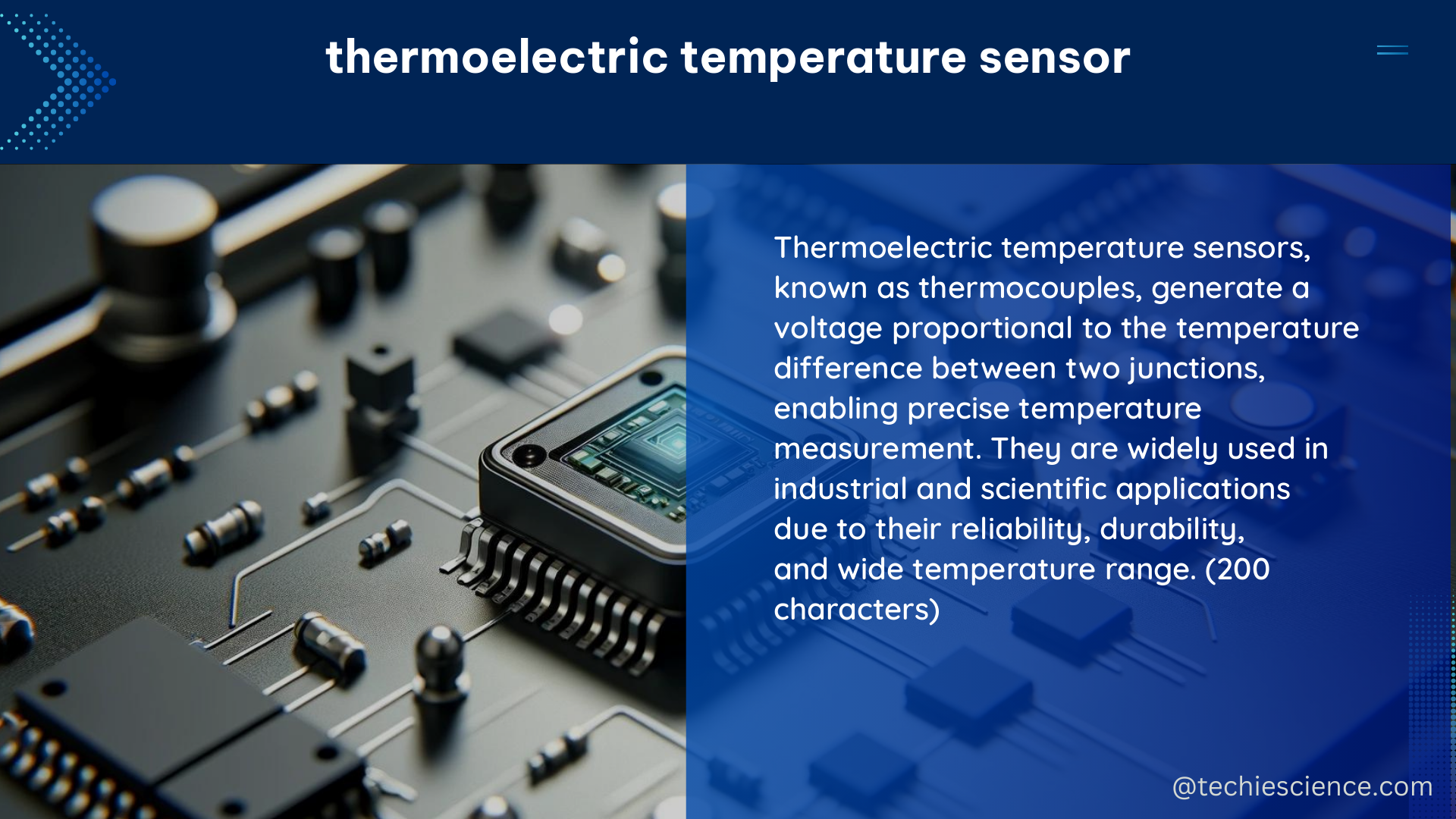Thermoelectric temperature sensors, also known as thermocouples, are a type of temperature sensor that measures temperature by converting thermal energy into electrical energy. They consist of two dissimilar metal wires joined at one end, forming a junction. When there is a temperature difference between the junction and the other end of the wires, an electrical potential difference is generated, which can be measured and correlated to the temperature difference.
Technical Specifications of Thermoelectric Temperature Sensors
The technical specifications of thermoelectric temperature sensors can vary depending on the specific type and application. However, some common specifications include:
Temperature Range
- Thermocouple type K: -200°C to 1260°C
- Thermocouple type J: -210°C to 1200°C
- Thermocouple type T: -270°C to 400°C
- Thermocouple type E: -270°C to 1000°C
- Thermocouple type N: -270°C to 1300°C
Sensitivity
- Thermocouple type K: Approximately 41 µV/°C
- Thermocouple type J: Approximately 50 µV/°C
- Thermocouple type T: Approximately 43 µV/°C
- Thermocouple type E: Approximately 68 µV/°C
- Thermocouple type N: Approximately 39 µV/°C
Response Time
- Thermocouple type K: Less than 1 second
- Thermocouple type J: Less than 1 second
- Thermocouple type T: Less than 1 second
- Thermocouple type E: Less than 1 second
- Thermocouple type N: Less than 1 second
Thermal Stability
- Thermocouple type K: Stable up to 1100°C
- Thermocouple type J: Stable up to 760°C
- Thermocouple type T: Stable up to 400°C
- Thermocouple type E: Stable up to 900°C
- Thermocouple type N: Stable up to 1300°C
Building a DIY Thermoelectric Temperature Sensor

To build a DIY thermoelectric temperature sensor, you would need the following components:
- Two dissimilar metal wires, such as:
- Copper (Cu) and Constantan (Cu-Ni alloy)
- Iron (Fe) and Constantan (Cu-Ni alloy)
- Chromel (Ni-Cr alloy) and Alumel (Ni-Al alloy)
- A way to measure the electrical potential difference between the wires, such as a voltmeter or a data acquisition system.
The basic steps to build a DIY thermoelectric temperature sensor are:
- Cut the two dissimilar metal wires to the desired length.
- Join the wires at one end to form the thermocouple junction.
- Connect the other ends of the wires to the voltmeter or data acquisition system.
- Calibrate the sensor by measuring the voltage output at known temperatures and correlating it to the temperature using the Seebeck coefficient for the specific metals used.
Advantages and Limitations of Thermoelectric Temperature Sensors
Thermoelectric temperature sensors have several advantages over other types of temperature sensors:
- Wide temperature range: Thermocouples can measure temperatures from -270°C to 1300°C, depending on the type.
- Relatively inexpensive: Thermocouples are generally less expensive than other temperature sensors, such as resistance temperature detectors (RTDs).
- Fast response time: Thermocouples can respond to temperature changes in less than 1 second.
However, thermoelectric temperature sensors also have some limitations:
- Lower accuracy: Thermocouples generally have lower accuracy compared to RTDs, with typical accuracies ranging from ±0.5°C to ±2.2°C.
- Nonlinear output: The relationship between the thermocouple voltage and temperature is nonlinear, requiring calibration and compensation.
- Cold junction compensation: Thermocouple measurements require cold junction compensation to account for the temperature at the reference junction, which can introduce additional errors.
Conclusion
Thermoelectric temperature sensors, or thermocouples, are a versatile and widely used type of temperature sensor that measure temperature by converting thermal energy into electrical energy. They offer a wide temperature range, fast response time, and relatively low cost, making them a popular choice for many applications. However, their lower accuracy and nonlinear output require careful calibration and compensation to ensure reliable temperature measurements. By understanding the technical specifications and considerations of thermoelectric temperature sensors, you can effectively utilize them in your DIY projects and applications.
References
- Quantitative thermal microscopy using thermoelectric probe in passive mode, A. Bontempi, L. Thiery, D. Teyssieux, D. Briand, P. Vairac, Rev. Sci. Instrum. 84, 103703 (2013).
- Quantitative thermal microscopy using thermoelectric probe in passive mode, A. Bontempi, L. Thiery, D. Teyssieux, D. Briand, P. Vairac, Research Article, October 08 2013.
- Temperature Sensors, Engineering LibreTexts, 2023.
- Detection and quantification of temperature sensor drift using probabilistic neural networks, M. Pereira, B. Glisic, Sensors and Actuators A: Physical, 295, 113292 (2022).
- Appendix E: Temperature Measurement System, Lakeshore, 2022.

The lambdageeks.com Core SME Team is a group of experienced subject matter experts from diverse scientific and technical fields including Physics, Chemistry, Technology,Electronics & Electrical Engineering, Automotive, Mechanical Engineering. Our team collaborates to create high-quality, well-researched articles on a wide range of science and technology topics for the lambdageeks.com website.
All Our Senior SME are having more than 7 Years of experience in the respective fields . They are either Working Industry Professionals or assocaited With different Universities. Refer Our Authors Page to get to know About our Core SMEs.